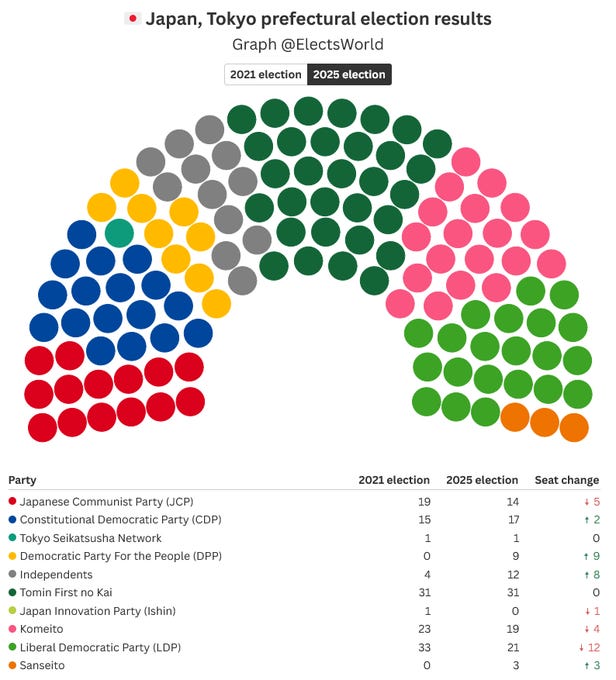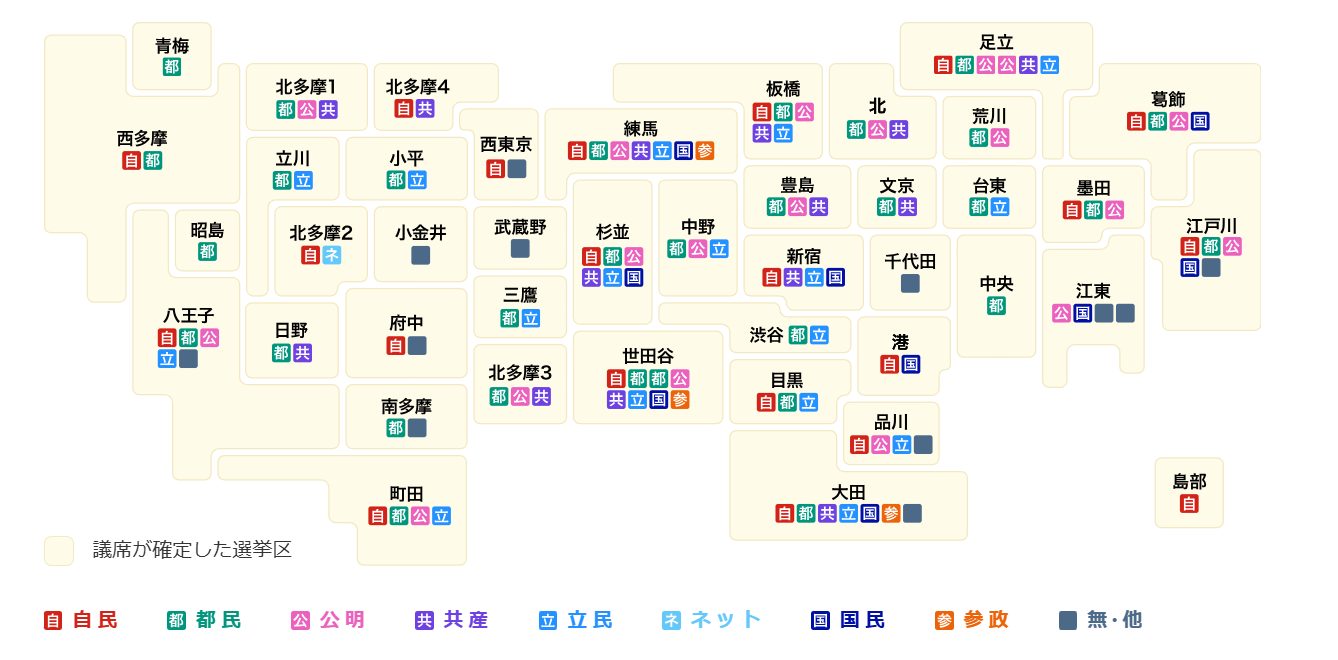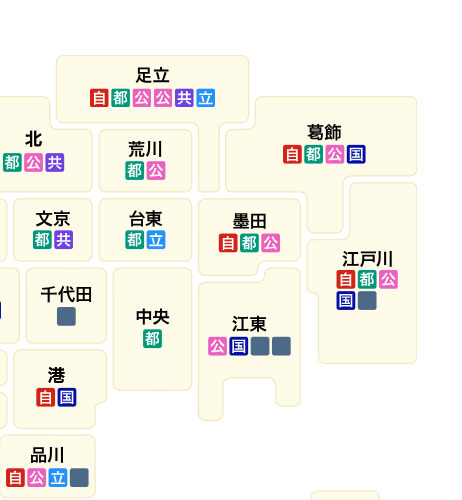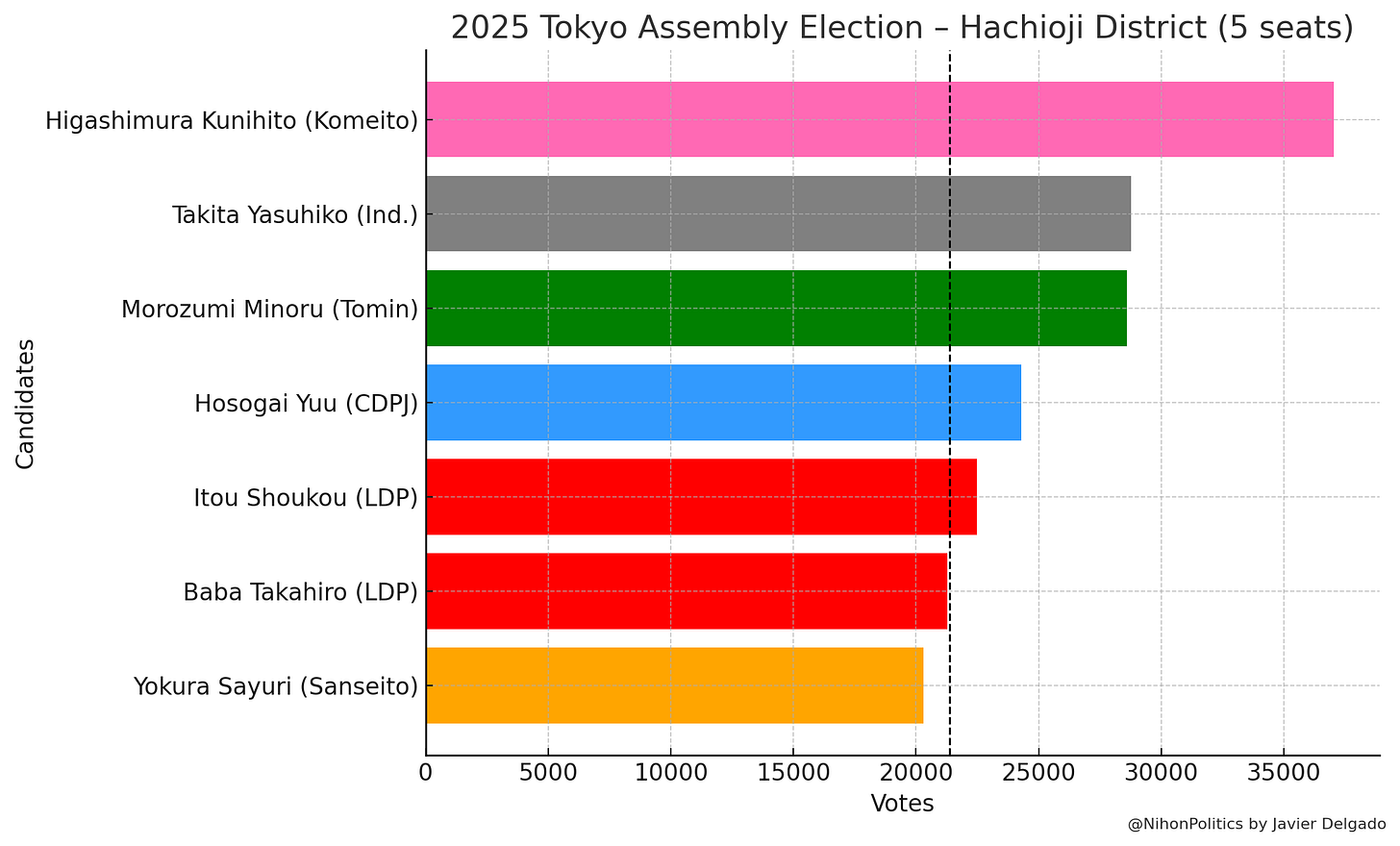Hello everyone,
Today marks just three days since the 2025 Tokyo Metropolitan Assembly election took place, and I’m here with a short entry for the newsletter, a first take on what the results tell us.
There’s a lot to digest. In less than a month, Japan will head into another national election: on July 20, voters will cast their ballots in the Upper House election, with the ruling LDP-Komeito coalition’s majority at stake.
But first, let’s break down what happened last Sunday in Tokyo.
Sunday’s results revealed a broader range of political groups and parties represented, even greater fragmentation than before. It reflects the broader national trend in Japan: a shifting, uncertain political era, where smaller parties are rising to meet the demands of disaffected voters.
WINNERS AND LOSERS
Tomin First (31 seats): WINNER
Governor Yuriko Koike’s local party managed to hold its ground in this election, maintaining the same number of seats as in 2021. While some pre-election polls hinted at potential gains, the rise in competition across the political center, particularly with parties like the DPFP, may have limited their ability to expand further.
As long as Yuriko Koike remains Governor of Tokyo, Tomin First will continue to have political life. The real question is what happens the day after her retirement.
While the party has managed to put down some local roots in Tokyo, it ultimately remains a movement built around Koike herself, and its success still depends heavily on her personal popularity and leadership. It’s worth noting that some of its current members once belonged to the old Democratic Party of Japan (DPJ) back in the mid-2000s, a reminder that Tomin First is less of a traditional party and more a coalition of pragmatists who rallied around the Koike flag and rode it high to the top of Tokyo’s political ranks.
🧩 Tidbits I found interesting:
In Chiyoda Ward, Tokyo’s political heartland, Taira Keisho was defeated in a shocking upset by just 246 votes. The winner? Saori Satō, an independent candidate loosely associated with the fringe anti-NHK party.
Damn, really, nobody saw this coming. I didn’t. This was one of the wildest surprises of the night.Tomin First continues its dominance in the far western reaches of Tokyo, at the foot of the mountains. In the city of Ōme, the party’s candidate won a record-breaking 68% of the vote, defeating the LDP by nearly 50 points.
LDP (21): LOSER
What can I say about the LDP? The party is in an extremely weak position nationwide, and Tokyo is no exception. With just 21 seats, this is the worst result EVER for the LDP in a Tokyo Metropolitan Assembly election. Even worse than 2017 and their 23 seats…
That said, there’s a catch: several of the newly elected independents were former LDP members, who were forced to run outside the party due to money-related scandals (surprise, huh?). So, they’ll likely return to the LDP parliamentary group, slightly inflating their numbers behind the scenes.
🧩 Tidbits I found interesting:
Part of the LDP’s historical strength was built on being able to win more than one seat in large multi-member districts, especially in big, populous wards of Tokyo like Setagaya, Nerima, or Ota. This year, there wasn’t a single place where the party won more than one seat, limiting their ability to inflate numbers.
It’s an interesting tidbit, and it points to real trouble ahead in the upcoming Upper House election, especially if the party can’t manage to secure multiple seats in large districts like Tokyo, Hokkaido or Chiba. It is a slow, painful way of bleeding votes.
The party astonishingly struggled in the smaller wards of Tokyo: not a single LDP candidate won a seat in Chiyoda, Bunkyo, Kita, Arakawa, Taito, or Chuo. Hell, central Tokyo, if that even exists, was a complete wipeout.
Not only that, the LDP struggled badly in all seven single-member districts of Tokyo, managing to win in only one. That should raise serious alarms ahead of the July Upper House election, where the opposition is expected to present unified candidates in many of the single-member districts nationwide.
KOMEITO (19): LOSER
Komeito, the LDP’s junior coalition partner, had a difficult night. It won 19 seats, down from 23 in 2021.
You could try to frame it as a sign of stability, after all, a four-seat decline isn’t catastrophic, but stability alone isn’t enough for Komeito right now.
The party is in structural decline, and Tokyo made that painfully clear: For the first time since 1993, not every single Komeito candidate won the seat they ran for. That’s three decades of perfection, broken. Honestly, it’s just crazy.
Still, eastern Tokyo, the old Joto-ku (literally "east of the castle", 城東区), came through like it always does and saved Komeito from a worse result.
Just look at the map: pink Komeito wins in Koto, Edogawa, Katsushika, and those two juicy seats in Adachi, where the party always performs well.
Adachi, one of Tokyo’s poorest wards, is also a Komeito stronghold, and it showed up once again for the party.
🧩 Tidbits I found interesting:
Ota Ward in southern Tokyo was the main culprit behind Komeito’s broken record. Two candidates, both incumbents, ran in Ota, cancelling each other out, and both lost their seats.
The votes were probably there to secure at least one seat, but just like in 2021 when they won here, the party chose to run both again and it backfired.Ironically, Ota is the hometown of Ikeda Daisaku, the founder of Soka Gakkai, the Buddhist lay organization that underpins Komeito.
Komeito also lost its seat in Shinjuku Ward, the location of Soka Gakkai’s national headquarters.
CDPJ (17): WINNER
Japan’s main opposition party, the CDPJ, slightly improved its position, winning two more seats than in 2021. It’s a much-needed boost ahead of July’s Upper House election, and their position is likely to improve even further (significantly) once some independent candidates decide to join their parliamentary group in the assembly.
This is actually the best result for a major progressive opposition party since 2009, a small but symbolic sign of realignment on the center-left.
This election matters because the CDPJ seems to be consolidating itself in Tokyo, especially in western Tokyo along the famous Chuo train line.
🧩 Tidbits I found interesting:
Independents backed by the CDPJ won in two key single-member districts: Koganei City and Musashino City. The race in Musashino, Tokyo’s most progressive city, was especially symbolic. The CDPJ reclaimed the seat, defeating an LDP incumbent after a string of disappointing results there over the past two years.
Related to the CDPJ, the female-led civic group Seikatsusha Network managed to hold onto its one seat in Kita Tama No. 2 district. The group has long maintained a small but consistent presence in Tokyo politics, occasionally picking up seats in progressive areas like Setagaya or Suginami.
JCP(14): LOSER
The Japanese Communist Party had a bad night, losing 5 seats. But in truth, the party may have been overstretched; 19 was their best since 1996, and this is more of a reversion to the mean of around 15 seats. They lost ground in eastern Tokyo, with incumbents defeated in both Edogawa and Koto Wards.
Looking ahead to the July Upper House election, the JCP will try to maintain its current national strength as it continues to grapple with a declining base of support, largely made up of an aging cohort of loyal voters.
🧩 Tidbits I found interesting:
Not exactly a surprise, but 13 of the 14 JCP winners were women.
They make up the core of the party’s ground game and electoral strength, especially among older female voters. They’re the Communists of Japan.In Shinjuku, Oyama Tomoko was elected for her 9th term in the Tokyo Metropolitan Assembly. That’s… impressive.
DPFP (9): WINNER
Yuichiro Tamaki’s Democratic Party for the People had the kind of night they’d been waiting for. From zero to nine seats in a single election, a real splash, and now they’re openly aiming to win one of Tokyo’s seats in the upcoming Upper House election. It's crazy. But it’s happening.
The party managed to win seats in a majority of Tokyo’s large districts, including Ota, Setagaya, Suginami, Nerima and Edogawa. They even snagged seats in Shinjuku and Minato Wards
This was a breakout night.
🧩 Tidbits I found interesting:
Currently, the party’s strength lies in multi-member districts, where a single candidate can sneak in and grab a seat with a strong enough share of the vote, amid crowded fields.
Although the party it’s probably at the lower end of its support estimates, polls suggest that the DPFP’s strength among younger and middle-aged voters, especially those who once leaned toward the LDP in the Abe Era, is more than enough to make an impression in the upcoming election and cause real trouble for the ruling party.
SANSEITO (3): WINNER
Well, well. Sanseito was probably the biggest winner of the night, maybe even ahead of the DPFP.
This far-right, fringe, borderline-loony political party is up and running. They snatched seats last Sunday in Ota, Setagaya, and Nerima, all populous urban wards.
They’re fighting hard. They’re a party with an aggressive online game, and now they’re openly aiming to win something even bigger in the upcoming Upper House election.
Sanseito is positioning itself to appeal not just to disenchanted LDP conservatives but also to anti-establishment, DPFP-leaning voters.
And… it could just work out. Beware, these aren’t your old-school Japanese conservatives; they’re young, conspiracy-minded, and just plain weird.
In any case, they are openly tapping into a growing concern in Japanese society or at least among certain segments of it: discomfort with the increasing number of foreigners and immigrants, and the perceived impact this has on the sense of 安心・安全 ("safety and security") in some communities.
To gauge their real strength in this election, I wanted to take a closer look at the four districts where the party actually ran a candidate, Hachioji, Nerima, Setagaya, and Ota, to assess how competitive they really were.
Setagaya Ward - 8 seats (1 seat won)
This was one of the first shocks of the night, when major outlets like Yomiuri Shimbun and Asahi declared early on that Sanseito had won its first seat, right here in Setagaya, one of Tokyo’s most liberal and residential districts.
And it truly was shocking: over 40,000 votes and a second-place finish.
Hachioji City - 5 seats (no seat won)
Hachioji was the only district where Sanseito failed to win a seat, but they were surprisingly competitive. They missed the cut by just 1% and around 2000 votes. In fact, they even finished ahead of two incumbents who lost re-election: an independent backed by the DPFP and a candidate from the JCP.
Nerima Ward - 7 seats (1 seat won)
Impressive result overall. Sanseito’s candidate received over 31,000 votes and more than 10% of the vote, finishing ahead of several long-time incumbents with decades in the Tokyo Assembly. In a crowded field like Nerima, they stood a real chance. Placing third was, frankly, a surprise.
Ota Ward - 7 seats (1 seat won)
Lastly, in Ota Ward, where Ishin no Kai used to hold a seat, both the DPFP and Sanseito managed to secure one this time. Notably, Sanseito’s candidate placed fourth, ahead of several long-time incumbents who ended up losing re-election, a clear sign of how strong their performance was in one of Tokyo’s most competitive districts.
What else?
ISHIN NO KAI (0): LOSER
Well… remember the guys from Ishin no Kai? Not anymore.
They lost their only seat, the one they barely won in Ota Ward back in 2021, and it wasn’t even close. Their incumbent, Matsuda, finished over 7,000 votes behind the last seat, which went to the CDPJ.
Tokyo continues to be an impenetrable wall for Ishin no Kai.
They’ve tried. They’ve failed. And at this point, they have nowhere to go but down.
REIWA (0): LOSER
The upstart leftist party led by Taro Yamamoto flopped hard in this election.
They only ran three candidates, in Nerima, Setagaya, and Suginami Wards, and none came even close to winning a seat. Honestly, I never had high expectations.
But still, it’s a bad omen for the party just a month before a national election, especially in Tokyo, where Yamamoto himself holds a seat in the Upper House, and where the party is hopeful to pick up another one in July.
Polls have shown Reiwa on a bit of an upward trend, and they might still improve their standing. But this result is definitely disappointing.
The problem is, the party is still basically non-existent at the local level, and breaking into assembly seats is really tough when you’ve got no base on the ground.
Another concern? Some polls suggest a portion of Reiwa’s anti-vax, “spiritual-leaning” voters might be shifting to Sanseito…
SAISEI NO MICHI (0): LOSER
Let’s be clear, the real loser of this election was Ishimaru Shinji and his group Saisei no Michi, who failed to elect a single one of their 42 candidates.
Yes, 42!!
This was the guy riding on high expectations after his surprise second-place finish in last year’s Tokyo governor race. But it just doesn’t work that way.
There was no clear reason to vote for any of his people, with no strategy whatsoever.
Honestly? Kind of deserved. I never thought much of this guy or his brand of politics. It’s over.
What Tokyo Just Told Us About July
👉The LDP is weak. It continues to carry the baggage of corruption scandals and a total lack of popular, energizing politicians. They’ll likely bet everything on Kozumi Shinjiro, the new Agriculture Minister, and his push to bring down rice prices.
Will it work? It didn’t in Tokyo. But he will try and he remains popular with the Japanese people.
👉Komeito is stuck in reverse, incapable of delivering, and certainly unable to rescue the LDP from its collapse.
👉Meanwhile, political fragmentation is getting wild in Japan, mirroring international trends. Tokyo voters just showed they’re more than willing to look beyond the usual suspects, with new options for voters.
👉The Japanese Communist Party faces an extremely difficult election with two of its three district incumbents at the risk of losing (Kyoto and Saitama).
👉The LDP is getting squeezed from two sides of the right, the fringe-but-growing Sanseito, and the opposition-leaning, reformist DPFP…
And just in a few days, Japan in its entirety goes to the polls for the House of Councillors Election. And I will be here for it!!
Thanks for reading!
If you enjoy my work, don’t forget to like, share, and subscribe, it really means a lot and helps me keep going. I truly appreciate it.
Time flies! I’m already working on the next article, coming in early July: a preview of the Upper House election, scheduled for July 20. Get ready. It’s going to be big.
Over the past few days, many of you have shown growing interest in deeper, more consistent content through this newsletter. It’s been incredible. 🙇♂️
So I’m working on something new.
Starting in July, Nihon Politics will enter its next phase: exclusive monthly insights, in-depth analysis, and feature articles on Japan’s political landscape.
More very soon. Thanks!
本当にありがとうございました!















